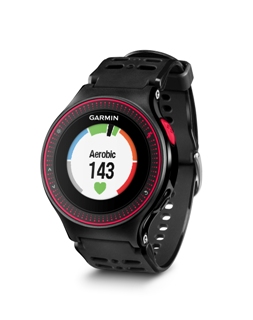Garmin International Inc., a unit of Garmin Ltd., today announced the Forerunner 225, the first Garmin GPS running watch that measures heart rate at the wrist. The Forerunner 225 will integrate industry-leading optical heart rate technology developed by Mio, an award-winning performance wearables brand acclaimed for EKG accuracy demanded by athletes everywhere.
 (Photo: Business Wire)
(Photo: Business Wire)
The Forerunner 225 features a colorful graphic interface showing runners their zone and beats per minute at a glance, and a built-in accelerometer that provides distance and pace data for indoor running with no need for a separate foot pod. To keep runners active between workouts, it doubles as an activity tracker counting steps, calories and distance. A move bar with vibration alert reminds users when they’ve been too inactive, and sleep monitoring for ample recovery.
“After more than 10 years of developing GPS running watches we are very excited to team up with Mio to introduce our first device featuring wrist-based heart rate,” said Dan Bartel, Garmin vice president of worldwide sales. “Getting and understanding your heart rate is more comfortable and easier than ever with the Forerunner 225’s real time results on a colorful gauge – allowing runners to evaluate and adjust effort quickly so they can focus on their run.”
“We are proud of our partnership with Garmin. When the leading brand in GPS teams up with a leading brand in wrist-based heart rate monitoring technology, it’s a win for athletes at all levels,” says Liz Dickinson, CEO of Mio Global. “More and more, athletes are recognizing the role that heart rate plays in their training intensity and efficacy, and it has become evident that heart rate is a must-have feature in wearable technology.”
How it Works
To measure heart rate at the wrist the Forerunner 225 uses a built-in optical sensor that shines light into a user’s skin and measures the amount of light returned. Because there are slight changes as blood pumps through the wrist, the sensor detects those changes and uses an advanced filtering process to determine reliable and accurate heart rate. Additionally, a light seal on the back of the watch blocks out ambient light to help ensure proper heart rate detection.
Easy to Understand Heart Rate Data
The Forerunner 225 displays a colorful gauge to show a runner’s zone and beats per minute in real time, allowing users to easily follow training programs that require set times or distances within a certain zone. The gray, blue, green, orange and red areas on the gauge show runners at a glance if they are in the warm-up, easy, aerobic, threshold or maximum heart rate zone. Zones are preset based on the user’s age-based max heart rate estimate but can also be customized directly on the watch or in Garmin Connect™.
Stay Active and Connected
The Forerunner 225 keeps runners on track with their training programs and encourages them to stay consistently active throughout the day. Water resistant to 50 meters1 and boasting up to four weeks battery life in watch mode with activity tracking and seven to ten hours with GPS and wrist heart rate active, the Forerunner 225 is optimal for training long hours in all conditions. During indoor runs its built-in accelerometer allows runners to capture accurate distance and pace data without needing a separate foot pod accessory. Available advanced workouts let runners of all levels create custom, goal-oriented workouts with vibration alerts for time, distance, calories and heart rate to push themselves to their highest potential.
Between workouts the Forerunner 225’s activity tracking features monitor valuable data including steps, distance, calories burned, and sleep, and its move bar with vibration alert provides motivation to stay active all day.
Connected features include automatic uploads to Garmin Connect, a free community where users can save, plan and share activities, social media sharing and live track. When paired with a compatible smartphone2 the Forerunner 225 will automatically upload a completed run to the Garmin Connect Mobile app for post-run analysis and instant sharing on social media sites. Runners can also use live tracking to allow friends and family to follow along during training or on race day to see stats in real time.